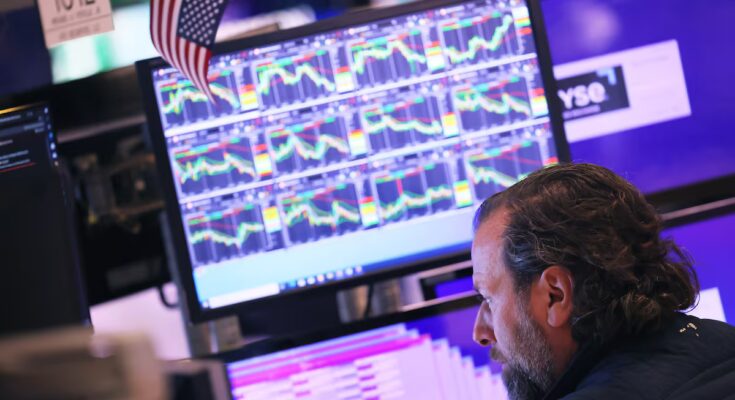Volatility has returned to the markets. The doubts that, due to the high valuations of large technology companies, generate more and more voices of alarm, have triggered days of sharp declines in global stock markets in the last week. After months of euphoria related to the development of artificial intelligence (AI), the US technology market has experienced a rude awakening. And although this is not the only reason behind the red numbers that have colored panels in recent sessions around the world – investors are also worried about the Federal Reserve’s monetary policy, political uncertainty in the United States and the effects of the 40-day federal government shutdown, which has deteriorated the availability of reliable economic data – the companies most exposed to the development of artificial intelligence are at the nerve center of stock market shocks.
The evolution of the Nasdaq Composite, the great tech thermometer, reflects that rollercoaster feeling. On October 29, the index reached its all-time high. Since then it has seen more negative sessions than positive ones, with several days where it lost more than 2%. And even if the decline is not significant, the fluctuations show some warnings to pay attention to. The nerves are more evident when one descends into the field of values.
The first warning sign came from Meta, when its shares plunged 11% in late October after it announced massive investments in artificial intelligence, which represented a significant setback to the symbolic character of being one of the magnificent seven. Nvidia, the main exponent of the investment fever for advanced chips, has accumulated a decline of 8% compared to the highs reached at the end of October. To some extent, the company was also hurt by profit-taking (Softbank sold all shares of the chipmaker). And Oracle, which has announced multimillion-dollar investments to avoid being left behind in the race for artificial intelligence, is down more than 31% from its September highs.
Nervousness is visible in the VIX, known as the fear index. When this indicator, which measures what the market demands to protect itself from future declines, is below 20 points, it is usually interpreted that the market is experiencing a phase of relative calm. Above that threshold, the message is one of tension and uncertainty. In the last few days it has gone from 19.08 points (last Friday) to 22.19 points on Thursday, with daily increases reaching 14%. A sign that risk perceptions have changed direction as doubts about artificial intelligence emerge.
Key to this shift is uncertainty about the future profitability of AI. Thomas Friedberger, CEO and co-chief investment officer of Tikehau Capital, points out that the enormous development costs associated with this technology “increase uncertainty about real profitability in the medium term. Recent events have confirmed our doubts. The emergence of DeepSeek illustrates the risk of misallocation of capital in an environment of rapid disruption.” His warning adds to the growing list of investors, managers, analysts and institutions who have warned in recent weeks that a bubble is forming around artificial intelligence.
The Bank of Spain warned in its latest report on financial stability about the risk that the overvaluation of technology companies represents for the markets due to their systemic potential and market concentration that can cause a contagion effect. Although Europe is not directly exposed to the companies leading the race for artificial intelligence, this Friday the Old Continent indexes lost around 1% after the previous day Wall Street had suffered its worst session of the month due to doubts about technology companies. “Large tech players often engage in mutual arrangements, such as cross-investments, shared infrastructure and bundled services, that hide true economic exposure. This interdependence can amplify systemic risk, as stress on one node can quickly spread across the network,” warns Marc-Antoine Collard, chief economist at Rothschild.
The International Monetary Fund (IMF) has already warned that US stock prices are trading 10% above what is reasonable. And Bank of England governor Andrew Bailey recently noted that we may be seeing a bubble in the making, because markets are “pricing in the uncertain future income stream.”
The doubts generated by this technology are not so much due to its transformative capacity, since few analysts doubt that it is reconfiguring the economy of the future. The uncertainty stems from the sheer volume of investments that companies are undertaking that may not translate into tangible benefits. “Investor enthusiasm has driven the sector’s P/E ratio to historically high levels, raising concerns about asset bubbles. Never before has so much capital been deployed so quickly into a technology that, despite its promise, remains a largely unproven source of profit,” adds Collard.
Big tech companies are under intense pressure because analysts believe their valuations are too high for their profits. A setback, weaker earnings guidance or more expensive-than-expected investments, or an IPO that doesn’t meet the desired valuation, could change market sentiment. Nvidia will present its quarterly results next Wednesday and the date is marked in red due to the effects it could trigger on the markets.
The context doesn’t help either, as reports note an increase in bearish positions. “Growing short interest serves as a warning sign that the easy gains of technology stocks may be behind us. The next few weeks will likely bring increasing volatility as markets reevaluate appropriate valuations for technology companies,” notes an S&P report.
The current correction does not necessarily mean the end of the tech rally, but it is a wake-up call for growth that seemed to have no limits. The market has started to discriminate more clearly between companies whose business is largely dependent on artificial intelligence (like Nvidia) and more diversified ones, capable of relying on other lines of business (like Apple or Microsoft). While almost the entire sector benefited equally during the upturns, the latter suffered more limited setbacks in the downturns. In any case, the AI rollercoaster has started its first stress curve since mid-2025, and the market is already starting to call for a balance between ambition and caution.



